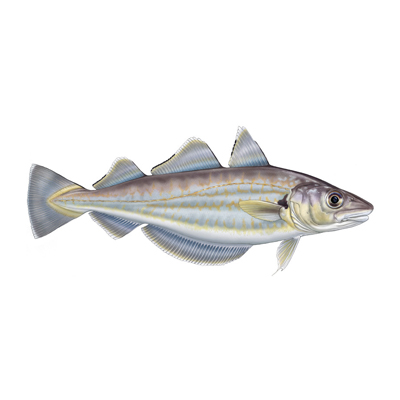

Whiting has delicate white flesh and is best used when very fresh. Sold whole and filleted, fresh or frozen. Also dried, salted and smoked.
Whiting stocks fluctuate naturally but have taken a downwards trend in the past five years with ICES advising zero catch in 2023 and 2024. This means that this species automatically gets a rating of 5 - fish to avoid.
Fishing effort is too high across the European fleet and this species is now no longer recommended by Cornwall Good Seafood Guide. Avoid eating fish below 30cm – this is the size at which they become mature.
A total of 163 tonnes of whiting were landed to Cornish ports in 2021, with a value of £188k (MMO data).
Updated July 2023
Cornish vessels landing to Cornish ports
Whiting are occasionally caught on handlines but it is rarely targeted.
Learn moreCornish vessels landing to Cornish Ports
Demersal trawls are large nets that are pulled through the water with the bottom edge of the net touching the seabed. At each edge the net is pulled open by metal ‘trawl doors’. Sometimes referred to as Otter trawling.
Learn moreCornish vessels landing to Cornish ports
Beam trawls are nets with a steel beam that holds the net open. The belly of the net is made of chains and the upper surface of the net is mesh. Beam trawlers pull two nets along the seabed simultaneously.
Learn moreCornwall Good Seafood Guide rates fish on sustainability using a scale of 1 to 5.
1, 2 and 3 are recommended, Fish to avoid are rated 5.
We use the system devised by the Marine Conservation Society (MCS) so our scores are comparable with the scores produced by MCS for the UK and fisheries from all around the world. For more information on scoring click here.
Whiting is a relative of cod, doesn’t grow as large (up to 70cm) they are sandy blue green colour. They like deeper cool waters. Whiting breed between January and July with peak spawning in March and April. They can live for up to 20 years and mature at an age of 2-3 years. Biological vulnerability for this species is relatively low 37% (Ref. Chung et al 2005, source www.fishbase.org) .
A species who's abundance naturally fluctuates in Celtic seas, whiting is a cold water species that has poor recruitment in warmer years. In 2017 stock levels suddenly fell below sustainable levels, (well below MSY) and fishing pressure on this species has increased with fishing levels now well above MSY (ICES). Landings of Whiting to Cornish ports have continued to decrease. There are some problems with discards of undersized and unwanted whiting and technical measures need to be developed to address this. Many SW trawlers are involved in Seafish gear modification trials that aim to improve gear to reduce unwanted catches of undersized or over quota whiting.
Whiting are mainly taken in mixed-species fisheries targeting cod, haddock, and whiting with otter trawls and gill nets. Trawling is associated with benthic impacts and high levels of bycatch. Discards, especially of 1 and 2 year old fish, are incredibly high due to the low market value of the species. Up to 75% of whiting caught can be discarded. Occasinally fishermen catch whiting when handlining or fishing with rod and line, this is a selective fishing method but with such poor stock status even handline caught fish are scored 5 under the scoring methodology used.






Cornwall Good Seafood Guide is underpinned by the Marine Conservation Society (MCS) Good Fish Guide. The first UK consumer guide to sustainable seafood. For more information visit www.fishonline.org
Cornwall Good Seafood Guide is here to help us all make sustainable seafood choices. Choices that will help us keep the oceans healthy and Cornish fishers' futures safe. This website is funded by Cornwall Wildlife Trust. If you would like to make a meaningful difference to the health of our oceans, please consider making a donation to the Cornwall Wildlife Trust Ocean Emergency fund. Your donation will help safeguard these remarkable environments, ensuring that they continue to thrive for generations to come. Together, we can be stewards of the seas and champions for a healthier, more sustainable future.